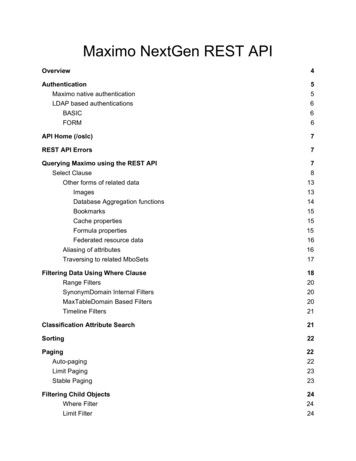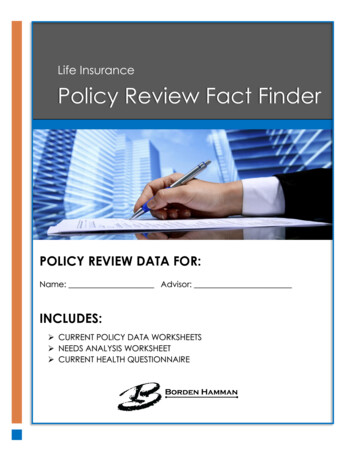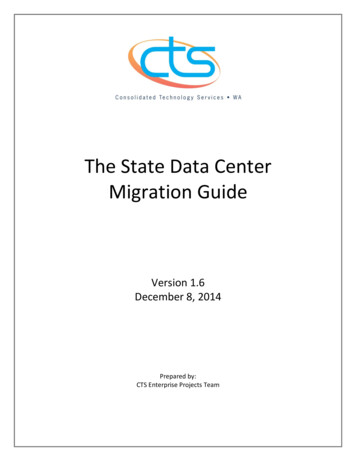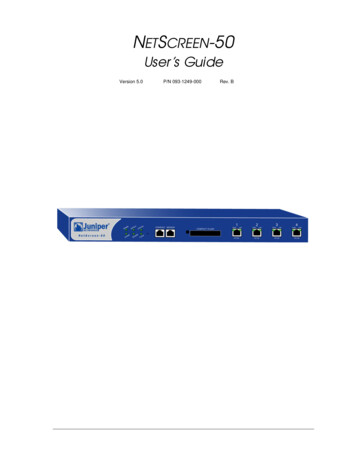
Transcription
GUIDE ONOUTCOME-BASEDSECURITY CONTRACTSSector Lead:Supported by:
ContentsSECTION 1 – INTRODUCTION TO OUTCOME-BASED CONTRACTING (OBC) FORSECURITY SERVICES . 1SECTION 2 – FEATURES OF OUTCOME-BASED CONTRACTS FOR SECURITYSERVICES. 2SECTION 3 – GUIDELINES FOR DRAFTING AN OUTCOME-BASED CONTRACT . 4SECTION 4 – EXAMPLES . 19SECTION 4-1 LIST OF TENDER INSTRUCTIONS FOR SECURITY OBC . 19SECTION 4-2 SAMPLE SCOPE OF WORK FOR SECURITY OBC . 24SECTION 4-3 MONTHLY PERFORMANCE EVALUATION MATRIX . 36SECTION 4-4 TENDER EVALUATION . 39
PrefaceThe Security Industry Transformation Map (ITM) was launched in February 2018. TheITM’s vision is to build a vibrant, technologically advanced and competitive security industrythat delivers better security for Singapore and better jobs for Singaporeans. One key strategyto achieving this, is to transform the industry to rely less on manpower by leveragingtechnology.This Guide on Outcome-Based Security Contracts is a step towards achieving thisvision. It aims to give service buyers step-by-step advice on how to write an outcome-basedcontract. This is important, because when buyers tender for services based on securityoutcomes rather than a fixed number of headcounts, security companies can innovate anddeliver more productive solutions that integrate manpower, technology and processes. Thiscan create better jobs, working conditions and employment terms for security officers.Service Buyers also benefit from better value from higher quality services at lower long-termcosts.In this guide, you will find practical examples, clauses and templates that can beincluded in tender requirements. It also suggests performance management indicators tomeasure outcomes, and templates to evaluate proposals based on price and quality. Wewelcome feedback (http://www.mha.gov.sg/feedback) on the Guide, which will becontinually updated to keep it relevant.The Security ITM Tripartite Committee thanks industry practitioners and tripartitestakeholders, who provided valuable suggestions as we developed this guide. We areconfident that this guide will help service buyers who are keen to switch to outcome-basedcontracts. Together, we can transform the security industry to keep Singapore safe and secure.
SECTION 1 – INTRODUCTION TO OUTCOME-BASED CONTRACTING(OBC) FOR SECURITY SERVICES1.1. Outcome-Based Contracting (OBC) refers to service buyers specifying contractrequirements in terms of expected performance levels, rather than output levels. In contrast,traditional output-based contracts specify fixed amounts of resources (e.g. manpower,equipment) that the service provider needs to supply.1.2. OBCs can lead to better solutions compared to output-based contracts. OBCs allowproviders to propose innovative security solutions that use less resources to meet desiredsecurity outcomes, by taking advantage of technology and re-designing of work processes.OBCs can improve cost-effectiveness and reduce manpower reliance. It is more sustainablefor buyers in the long term, given rising manpower costs.1.3. This guide applies to security services to protect buildings and premises. It providesbuyers with guidelines and templates on how to adopt OBCs, from planning a tender toevaluating bids. Buyers can adapt the guidelines and templates for their own requirements.Page 1
SECTION 2 – FEATURES OF OUTCOME-BASED CONTRACTS FORSECURITY mentFrameworkAdaptivePricing toRegularContractReviews2.The key features of OBCs for security services are:2.1.Outcome-Based SpecificationsOutcome-based specifications describe security outcomes, operational parametersand performance demands instead of just specifying output (e.g. headcount). Thisgives providers the flexibility to offer the most effective solution by integratingmanpower, technology and operational processes. Refer to Section 3 on best practices to develop an outcome-based scope of workand Section 4-2 for a sample scope of work for security OBC.2.2.Outcome-Driven PerformanceThe performance of the providers shall be tracked against desired security outcomes.A performance management matrix can be utilised and should include bothquantitative and qualitative metrics to assess the performance of the providers.Buyers will need to formulate metrics that best meet their requirements in theoutcome-based specifications. Refer to Section 3 on best practices to implement outcome-driven performancemanagement and Section 4-3 for a sample performance evaluation matrix.2.3.Quality-Focused EvaluationQuality attributes should take on heavier weightage compared to price duringevaluation of an OBC. The emphasis on quality benefits providers who provide clearand convincing explanations of how their proposal will achieve the desired outcomes. Refer to Section 3 on best practices to evaluate OBC and Section 4-4 for a sampleof tender evaluation report.Page 2
2.4.Productivity Enhancement FrameworkContinual process enhancements should be part of OBCs. As providers understandoperations better over time, they should be incentivised to propose changes whichare able to achieve the same security outcomes at lower cost and with more efficientuse of resources. That said, it is essential that providers understand that theirresponsibilities and contractual service levels must be maintained when any suchproposal is implemented. Refer to Section 3 on best practices to enhance productivity in OBC and Section 42 for a sample scope of work for security OBC.2.5.Adaptive Pricing to Regular Contract ReviewsOBCs must have flexibility to adapt to changing market conditions and governmentregulations. By doing so, it allows risk to be shared between buyers and providers in afair and open manner. However, in cases where inflation-driven cost adjustmentformulas are applied, buyers should take into account the wage requirements underthe PWM, when considering any downward price adjustments (e.g. due to negativeeconomic conditions). Refer to Section 3 on best practices for adaptive pricing and Section 4-2 for a samplescope of work for security OBCPage 3
SECTION 3 – GUIDELINES FOR DRAFTING AN OUTCOME-BASEDCONTRACT3The security service procurement process typically consists of three stages. Buyersshould set reasonable timelines for each stage - pre-tender, tender drafting andtender evaluation. As a general rule, at least three months should be set aside. Thissection details the process and best practices for the different phases.3.1Pre-Tender Stage – Getting started on OBCs3.1.1 Planning for procurement should be conducted as early as possible. This is when thereis the greatest potential to propose significant ways to enhance security and improveproductivity.a.Enhancing Security Operations Upstream. At the strategic level, buyers shouldreview opportunities to enhance security operations and derive productivity savingsthrough infrastructure development and demand aggregation. When newinfrastructure is built or existing infrastructure retrofitted, buyers can incorporatesecurity procedures, physical protection concepts and security technology into thebuilding’s security design and plans. Clustering security demand can also often achievebetter synergies in operations and resource efficiency. Clustering can be donegeographically (i.e. multiple sites within the same geographical location) or within anorganisation (i.e. different sites within the same organisation). Clustering needs to bedone with awareness of contracting timelines and provisions to allow smooth onboarding of the various sites. This should be planned at least a year before the tenderis called.Page 4
b.Security Risk Assessment. It is important for buyers to be able to define securityoutcomes and understand how security outcomes are being met when a proposal isput forth in an OBC. Security risk assessments will provide buyers with an evaluationof security risks in a given operating site through analysis of threats, vulnerability andconsequences. At least 3 months should be set aside if buyers are undertaking acomprehensive security assessment outside of the Tender.c.Market Surveys and Pre-Qualification of Providers. Buyers should assesspotential providers to determine their suitability to participate in the tender, througha market survey or a Request for Information (RFI). Buyers should set aside at leastone month for this process, which will involve discussions with potential providers.Buyers can consider pre-qualifying providers and invite them to bid for the tender.3.2Tender-Drafting Stage – Incorporating Outcome-Based Requirements in TenderDocuments3.2.1 Buyers should incorporate outcome-based requirements into tender documents thatclearly communicate the expectations and standards expected from the providers.The table below summarises the suggested best practices during tender drafting.Section3.2.1.1 Tender InstructionsPracticesa. Security risk assessmentb. Operational modelc. Resource pland. Transition plane. Price schedulef. Grading and accreditationg. Company profile and experienceh. Evaluation criteriai. Clarifications3.2.1.2 Scope of Worka.b.c.d.e.f.g.Contract durationArea of coverageOperational hoursSecurity outcomesOther servicesSurges and contingenciesAdditional obligations3.2.1.3 Performance managementa.b.c.d.Performance metricsPerformance evaluation matrixIncentives for good performanceService failure3.2.1.4 Pricing Modela. Fixed pricing model ORb. Price review modelPage 5
Tender Instructions3.2.1.1 Tender instructions refer to instructions to guide providers in the submission ofinformation needed for evaluation. Instructions should be clearly laid out andtemplates given whenever possible. There are seven broad categories of informationthat buyers should include in an OBC tender instruction.a.Security Risk Assessment. A security risk assessment needs to be done prior tocontracting. Buyers can consider two ways of building this into their procurementprocess:Security Risk Assessments can be conducted in two ways:(i) Separate/Comprehensive. This is a security assessment that is doneseparately and before the tender for security services is called. It is acomprehensive assessment of the infrastructure plans and operations,done by external or in-house security consultants. The consultants willpropose desired security outcomes with a corresponding securitytechnology and operating concept plan. Deliverables could include drafttender specifications which the buyer can use. As this assessment takestime and is costlier, it is recommended mainly for buyers who havecomplex, high-security or multiple premises to secure.(ii) Integrated/Basic. This is a condensed security assessment which isintegrated into the tender process. It is best suited for buyers who havesmaller premises where such an assessment can be conducted by securityservice providers as part of developing their tender bids. This securityassessment should provide the rationale and planning parameters forproposed solutions, and how the solutions will meet the identified securityoutcomes.b.Operational Model. Buyers should request providers to submit a detailedproposal on their operational model. The proposal should explain how the manpower,processes, infrastructure and technology will be integrated effectively to mitigatesecurity risks identified by the security risk assessment as well as performancedemands specified in the tender documents.Page 6
c.Resource Plan. Buyers should encourage providers to adopt technology andwork process that can maximise efficiency of their manpower to meet the stipulatedsecurity outcomes. Should buyers require providers to use equipment that are ownedby the buyers, the list of equipment should be provided in the tender documents.Buyers could also specify in the tender documents, any operating systems ortechnology that they want the providers to use. Buyers may refer to the ProductivitySolutions /techdepot/en/psg.html) for a list of pre-approved technology solutions to include in theirrequirements. Buyers should assess the providers submitted list of equipment,materials, schedule of work and deployment proposal/plan for their suitability andeffectiveness.d.Transition Plan. Buyers should request providers to submit a transition plan toshow the timeline for operations to ramp up to full operational capability under theproposed operating model. The plan should provide explanations on how changemanagement and technology deployments would be performed (if applicable) andwhat measures would be implemented if transition plans goes beyond the buyers’stated deployment timelines. Note:Technology and infrastructural changes may require a transitional periodbefore full operational capability is achieved. The Tenderer must maketransition periods clear and explain how interim operations would besupported.e.Price Schedule. Buyers should define the baseline and ad-hoc or surge serviceitems for price submissions. This would form the basis for price assessment during thetender evaluation stage. Ad-hoc or surge services should be offered as separatescheduled rates as the frequency of recurrence is unknown. This removes the needfor providers to cater for capacity buffers in the price submission. Otherwise, buyerswill end up bearing the costs for provisions that are not utilised.f.Grading and Accreditation. Every security agency has a grading from the SecurityAgency Grading Exercise (SAGE) conducted by the Police Licensing and RegulatoryDepartment (PLRD). The grade of a security agency reflects its professionalism, abilityto delivery security outcomes and its track record in complying with employment laws.Buyers are encouraged to specify the SAGE grading of providers required. This couldform part of the quality evaluation.Page 7
g.Company Profile and Experience. Buyers can also request for additionalinformation related to the company profile and experience which could be factoredinto evaluation. This should be worked out concurrently with the development of theevaluation criteria and their parameters.h.Evaluation Criteria. Buyers should communicate the evaluation criteria for thetender in the tender documents. This offers transparency in the evaluation ofsubmitted proposals and will help providers in proposing the appropriate operationalmodel and resources to meet the security outcomes.i.Clarifications. Buyers should include contact details of the procurement officersshould providers require further clarifications on the tender requirements andsubmission.Scope of Work3.2.1.2 This section states the key elements to be specified by the buyers in order for theproviders to plan and prepare the proposal for the required security services.a.Contract Duration. Definition of the firm and optional contract period.Establishing longer contract durations would translate to stable services and loweramortised cost for use of technology solutions. Longer contract duration also helpsproviders to retain talent who are familiar with the job requirements and workingenvironment, allows providers to invest in training, and provides a longer costrecovery period for technology investment. As a guide, buyers can consider a contractperiod of at least three years. Buyers can extend this to cover the nature of contractextension (e.g. lead time to notify contract extensions) and how it will affect pricingcomponents (e.g. schedule rates and optional services)Recommended contract duration(i) Contract with less than S 1M estimated annual contract value should havea minimum of a three-year firm contract period.(ii) Contract with more than S 1M estimated annual contract value shouldhave a minimum of a five-year firm contract period, or three-year firmcontract period with two-year option period.b.Area of Coverage. Definition of the area of deployment which falls under thescope of the contract. It can include projections of peak or low activity volume atdifferent locations. Sensitive or inaccessible areas which require increasedsurveillance or higher security classification should be flagged out in the requirements.Page 8
c.Operational Hours. Definition of the deployment hours which services are to berendered or any specific schedules that affect operational activities on the ground.d.Security Outcomes. Definition of the type of security services to be rendered,the operating parameters which needs to be considered, with correspondingexplanations and performance measurements on the outcomes to be achieved.Security outcomes are major factors which affects how operations will be run and willbe the reference point in deciding if services provided were adequate. Securityoutcomes should be defined by buyers based on an understanding of what the existingoperations can achieve and whether there is a need to impose more stringentdemands. Overly stringent demands can drive up costs unnecessarily. Service levelrequirements set should also be reasonable and achievable by the providers. The tablebelow illustrates sample outcome-based statements based on desired outcomes thatbuyers can adapt for use when drafting tender requirements.Desired OutcomeProtection ofoccupants andpropertyoooSecurity withominimal servicefailure and timely oservice recoveryoSense of securityand visiblepresenceooooExamples of Outcome-Based StatementsAll visitors must be registered in the Visitor ManagementSystem and issued visitor passesNo incidents relating to loss or damage of propertyAll intrusions are detected, recorded and correct responserenderedEnsure 80% of visitors with registration waiting time fiveminutesAchieve overall customer satisfaction of security services ofat least 80%CCTV systems provided has system availability of 95%,failures are rectified within two hours.Ensure number of complaints per month is less than fiveAll scheduled patrols were conductedEnsure 90% attendance of SOsEnsure number of incidents where SOs fail to respond within15 minutes is less than five per monthe.Other services. Defining other secondary duties that providers are obligated toperform as part of security duties. (e.g. provide helpdesk services to direct visitors).Such tasking should be kept minimal to allow providers to focus on security operationsand Buyers should only include work functions that compliment security operations.For non-security related functions (e.g. landscape management), buyers shouldspecify that providers can provide non-security-trained staff to undertake thesefunctions.Page 9
Note:As part of fair contracting terms, buyers should be clear that services notincluded in the scope of work but are requested during the contractperiod shall be considered additional services for which fair remunerationshould be provided. If this principle is adhered to, service offers fromproviders will not have to factor in buffers for unknown needs which canunnecessarily increase prices.f.Surges. Defining how surges would be handled and how fast providers will needto response if surge demands are encountered. As a norm, surge demand should notbe factored into routine needs and should be included as additional scope of work.Example of possible demand surges: Hosting of events on site, heightenedsecurity alerts etc.(i) Known surges. Buyers could define such surges and what is expected fromthe providers when it occurs. If requested as a Tender submission request,providers can be requested to submit a proposal of their response plansand price package for every activation of such surge demand.(ii) Unknown surges. Surge demand provisions can be worked out with theprovider whenever the buyer identifies a need during the contract period.This gives buyers the assurance that surge demands can be met.g.Additional Obligations. These are broad demands that buyers may include asareas which providers have to abide with such as: Training and competency demandsCode of conductConduct of audits and reviewsSafety management and liabilitySecurity screening of providers’ officersSupply of providers’ furnished equipment and their specificationsUse and maintenance of buyers’ security equipmentContractual review points and price review mechanismsProductivity enhancement frameworksObligation for periodic contract demand reviewsPage 10
Performance Management3.2.1.3 To encourage providers to deliver good service, Buyers can tie performance indicatorsto desired outcomes. One practical model is the use of performance-based paymentsto reward Providers who have performed well based on what the service-levelrequirements. It should not be used to penalise Providers to lower prices. ShouldBuyers decide to adopt a performance-based payment model, the followinginformation on how payment is pegged to the performance scores should be includedin the tender documents:a.Performance Metrics. It is important for buyers to determine clear, measurableperformance metrics (both quantitative and qualitative) that are linked to securityoutcomes in the tender documents for subsequent evaluation of contractualperformance. How performance data will be collected and calculated to evaluateperformance must be clearly defined.b.Performance Evaluation Matrix. Buyers should track the performance of theproviders’ performance based on a performance evaluation matrix. The performancematrix should clearly reflect all the metrics that will be used to assess the performanceof the service provider. Refer to Section 4-3 for a sample performance evaluation matrix.c.Incentives for Good Performance. In order to encourage providers to meet orexceed performance standards on a regular basis, buyers are encouraged to adoptsome form of reward system to incentivise providers. Buyers may choose to adopteither the non-monetary reward system, or the incentive payment model or both.Example of incentives:(i) Monetary Rewards (Recommended). Monetary rewards can be in the formof a percentage of payment sums issued at periodic intervals to providers.It is important to state that such rewards are to be shared betweenproviders and their officers, to incentivise officers to play a proactive rolein meeting the outcomes. A general guide would be 30% to providers and70% to their officers, coupled with provisions for buyers to validate thatthis was apportioned fairly.(ii) Non-Monetary rewards. This can be in form of periodic appreciation eventsor gifts for individual officers. Buyers can also leave it to providers topropose a reward system.Page 11
d.Security Failures. Because of the nature of security services, it is not practical tomanage all security failures using performance indicators. Failures of these nature willhave to be dealt with whenever they are detected. To discourage occurrences ofsecurity failures, contractual tools (e.g. warning letters, payment mechanisms,disqualification from contract option extension, or termination) could be applied.Monetary disincentives should always be reasonable and proportional with the natureof the failure, and buyers should be mindful that unreasonable pricing may affectfinancial positions of providers and the ability to pay their workers. Contracttermination should apply in cases where persistent failures continues and there isclear evidence that the provider is not capable of delivering contracted outcomes. Ifthe contract is terminated, a reasonable timeframe should be considered and reasonsfor the termination made known to the provider.Example: Performance-Based Payment ModelBuyers should specify the payment model detailing the frequency ofperformance evaluation and minimum score to be attained for thecorresponding payment amount. The payment amount which is to be appliedcan vary and should be decided by the buyers depending on the criticality andimpact of security lapses to operations. Providers can then price in their riskprovisions according.For example, when the buyer sets a minimum total score of 24 per month, theprovider will receive full payment when a minimum score of 24 (i.e. total scoreacross six indicators) is achieved for the month.Sample Payment ModelScore27 (Bonus)24 – 26 (Baseline)10 - 23 (Below Average) 10 (Poor or Security Failure)Monthly Payment105% Payment100% Payment95% Payment90% PaymentIn this example, when the buyer set an incentive payment of 105% payment,assuming each indicator has maximum score of four for meeting baselineexpectation and one bonus point when performance exceeds expectations.Provider will need to exceed performance in three out of six indicators in orderto reach a total score of 27.Page 12
Conversely, to discourage poor performance / security failure, buyers can tierpayment according to the set payment model.If contract termination in event of repeated poor performance or repeatedsecurity failure is to be applied, the grounds for termination must be clearlystated. Buyers should also allow adequate notice periods and provide cleartransitional plansIn addition to the above, buyers may wish to include a clause to preserve theusual rights of parties at law that can be exercised in addition to the contractualrights.Pricing Model3.2.1.4 Buyers can choose to adopt a Fixed Price Model or Price Review Model for the contract.Although a Price Review Model is more complex, it is useful for longer-term contractsas its allows even sharing of pricing risk, which could be unknown at the point ofcontracting. It also avoids situations where providers are forced into unsustainableoperations due to external conditions. As part of fair contracting terms, buyers mayalso include terms that allows reasonable changes in prices if providers are able toprovide justifications on basis of unforeseeable circumstances (e.g. force majeureevents) that can lead to higher operating costs during the contract period.Pricing Models:(i) Fixed Pricing Model. Contractual rates remain constant throughout thecontract period; any changes will be subject to mutual agreements viacontract variations.(ii) Price Review Model. Baseline rate is established for a defined periodcoupled with established means of reviewing the prices to account forexternal price changes. Provisions for pricing reviews could include one ormore of the following: Fixed percentage price escalation which can be proposed by provider ordefined by buyer Cost adjustment factors using formulas that take into differenteconomic indices Obligations to review pricing in event of government policy changeswhich has cost impact on resources. (e.g. PWM reviews) Obligations to co-share savings in event provider is able to receivetechnology or productivity grants or subsidies from government forcontracted operations.Page 13
Note:Contractual price reviews can be complex if pre-agreed principles are notestablished in contract. As part of fair contractual terms, contracts shouldinclude clauses that allows both parties to call for a termination ofcontract in accordance with mutually agreed notice periods. If necessary,termination may be restricted to specified conditions for both parties.3.3Tender Evaluation Stage – Selecting the Best Provider for the Job3.3.1 After the tender has closed, buyers should conduct a tender evaluation in an organisedmanner based on pre-determined quality criteria, weighted against pricing. Beyondevaluation to select recommended offers, buyers should also assess the sustainabilityof offered prices from the selected tenderer. The table below summarises the stepswhich buyers can take to evaluate and select the best provider for the job.Steps3.3.1.1 Ensure a holistic evaluationPracticesa. Cardinal requirementsb. Evaluation parametersc. Tender interviews and reference checks3.3.1.2 Using Price-Quality Method a. Determine the weightages for Price and(PQM) as the evaluation frameworkQuality criteriab. Set up the scoring system for Pricec. Set up the scoring system for Qualityd. Aggregating the P-Score and Q-ScoreEnsure a Holistic Evaluation3.3.1.1 Cardinal requirements and evaluation criteria should be clearly marked out in thetender documents. In addition to the procurement officers, relevant personnel whowill oversee the providers should be invited to sit in the Tender Evaluation Committee(TEC). Communicating the evaluation criteria to the TEC early during the tender stagewill help align their expectations with the outcome of the security contract.a. Cardinal Requirements. These are requirements specified by the buyers in thetender instructions which are mandatory for providers to fulfil as part of tendersubmission. Upon receipt of the tender proposals, the TEC should reviewsubmissions to determine if the proposals have met the cardinal requirements. Anyoffers not in compliance should be deemed invalid and excluded from evaluation. Refer to Section 4-1 for a sample list of tender instructions for security OBC.Page 14
b. Evaluation Parameters. Buyers should communicate the evaluation criteria for thetender in the tender documents to help providers better understand therequirements and propose the operational model and resources that best meet thesecurity outcomes. The evaluation parameters would also serve as guidelines tohelp the TEC score each criterion. Buyers can consider using the Price-QualityMethod (PQM) as the evaluation framework.c. Tender Interviews and Reference Checks. Buyers can also arrange interview sessionswith shortlisted providers after the tender has closed. These sessions allow buyersto better understand the value proposition offered by the providers and clarify onthe different proposals submitted. Buyers can also conduct refere
A performance management matrix can be utilised and should include both quantitative and qualitative metrics to assess the performance of the providers. Buyers will need to formulate metrics that best meet their requirements in the outcome-based specifications. Refer to Section 3 on best practices to implement outcome-driven performance management and Section 4-3 for a sample performance .










